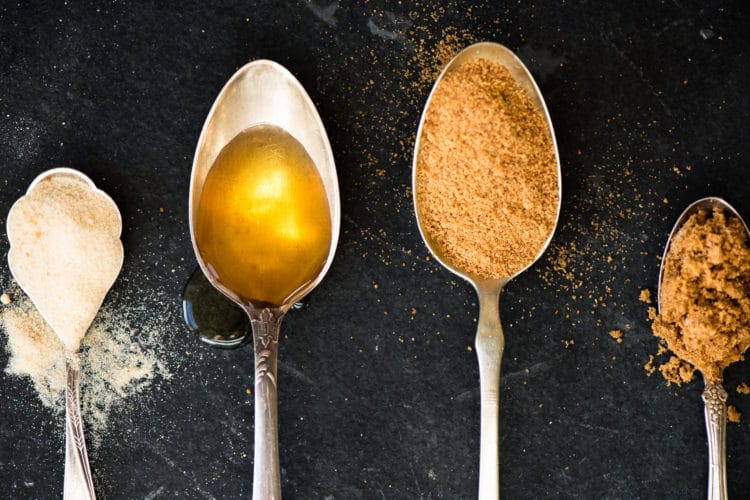Sugar has received a large share of media coverage over the past decade. Accused of being toxic, addictive and the cause of obesity, it makes our job as health professionals even more challenging when trying to separate fallacies from facts. Of course, we know that sugar, and more specifically glucose, is the body’s primary energy source and, therefore, essential to health. And while the majority of glucose is provided by starch from grains and some vegetables, it also is obtained from naturally occurring and added sugars. In this article I will delve into sugar science and recommendations to help you clear up confusion.
Sugar 101
When people think of sugar, the white stuff in the sugar bowl – sucrose – most often comes to mind. But sugar comes in many forms including monosaccharides (glucose, fructose and galactose) and disaccharides (sucrose, lactose and maltose). Lactose in milk is a combination of glucose and galactose while the sugars in fruits, vegetables and nutritive sweeteners (white and brown sugar, honey, high-fructose corn syrup and agave nectar) are a combination of fructose and glucose.
Sucrose, a disaccharide composed of half fructose and half glucose, is hydrolyzed in the small intestine by an enzyme, sucrase, to yield fructose and glucose. On the other hand, honey, high fructose corn syrup and agave nectar contain the individual monosaccharides, fructose and glucose. Honey is about half fructose and half glucose; HFCS is either 55 percent fructose and 42 percent glucose (primarily found in sweetened beverages) or 42 percent fructose and 58 percent glucose (used as an ingredient in other packaged foods); and agave nectar ranges from 56 to 90 percent fructose with the remainder primarily glucose. Fruits and vegetables are also comprised of both fructose and glucose with almost all between 40 to 60 percent fructose. After absorption, the body is unable to distinguish the original source of the fructose, glucose, or any other sugar.
Once absorbed in the small intestine, glucose enters the portal blood and is transported through the body. Elevated blood glucose levels result in insulin release and glucose uptake into cells. Glucose is primarily stored in the liver and muscles as glycogen. When blood glucose levels fall, the hormone glucagon triggers glucose release into the bloodstream.
Unlike glucose, fructose does not require insulin for metabolism. Fructose is absorbed from the small intestine into the portal blood and transported to the liver.
In the liver, about 50 percent of fructose is converted to glucose, 25 percent to lactate, 15 percent to glycogen and 3 to 5 percent to triglycerides.
In addition, the transporters that are involved in sugar transport into cells differ.
Sugar Guidelines
A variety of organizations have issued guidance on intake of added sugars. The American Heart Association recommends limiting added sugar to 6 teaspoons for women and 9 teaspoons for men/day. That’s the equivalent of about 100 calories for women and 150 calories for men.
The World Health Organization advises both adults and children reduce the intake of free sugars to less than 10 percent of total calorie intake. WHO defines free sugars as “monosaccharides and disaccharides added to foods and beverages by the manufacturer, cook or consumer, and sugars naturally present in honey, syrups, fruit juices and fruit juice concentrates.”
The 2015 – 2020 Dietary Guidelines for Americans suggests for a healthy eating pattern that individuals consume less than 10% of calories per day from added sugars. According to the Guidelines, this is not a Tolerable Upper Intake Level set by the Institute of Medicine (IOM). Rather, after eating the recommend servings from each food group, there are not enough calories remaining to consume more than 10 percent from added sugars and stay within daily calorie limits for most people.
Nutrition Facts Panel Changes
In May 2016, the FDA announced changes in the Nutrition Facts label for packaged foods. For the first time “Added Sugars,” in grams and as a percent Daily Value, will be included. The final rule requires “Includes X g Added Sugars” to be listed directly beneath “Total Sugars.” The agency defines added sugars as those either added during food processing or packaged as such. These include monosaccharides and disaccharides, as well as sugars from syrups, honey and concentrated fruit or vegetable juices that are “in excess of what would be expected from the same volume of 100 percent fruit or vegetable juice of the same type.”
The Bottom Line
When advising consumers about sugar consumption, MyPlate is a useful guide for a healthy eating pattern. Within the servings recommended from each food group, people should choose their sugars “by the company they keep.” That is, selecting nutrient-rich foods that provide additional nutrients along with sugar such as sweetened yogurt or cereal or flavored milk. In this way, they can enjoy the sweet taste of sugar while also meeting their needs for a nutritionally adequate diet.
Patients that need to reduce calories and carbohydrate intake could use low-calorie sweeteners that provide sweet taste without the carbohydrate or calories in sugar. Those with high levels of physical activity may benefit from education related to timing of nutrition and exercise performance while individuals with diabetes may need counseling regarding carbohydrate intake and medication dose and timing, particularly related to insulin.
 Neva Cochran, MS, RDN, LD is a registered dietitian nutritionist based in Dallas. She serves as a nutrition communications consultant to a variety of food and nutrition organizations, including the Calorie Control Council. She is passionate about promoting fact-based food and nutrition information to help people enjoy nutritious eating. Follow her on Twitter @NevaRDLD and check out her blog at www.NevaCochranRD.com
Neva Cochran, MS, RDN, LD is a registered dietitian nutritionist based in Dallas. She serves as a nutrition communications consultant to a variety of food and nutrition organizations, including the Calorie Control Council. She is passionate about promoting fact-based food and nutrition information to help people enjoy nutritious eating. Follow her on Twitter @NevaRDLD and check out her blog at www.NevaCochranRD.com

